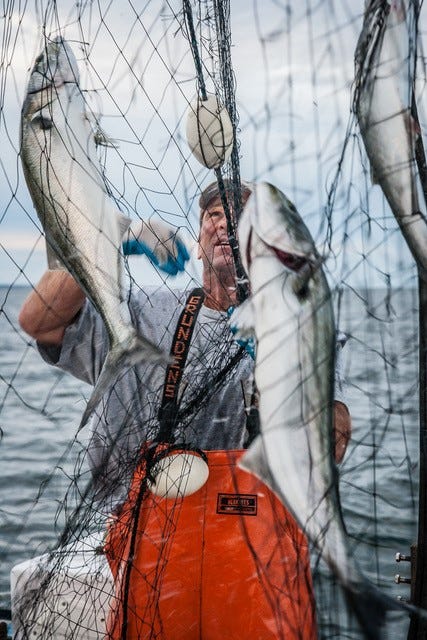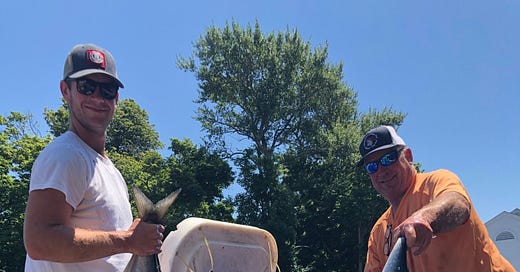A Cape Cod delicacy called bluefish
Treat them right and they're as good as fish get. Just ask Tom Smith.
No one catches bluefish like Tom Smith.
No one handles bluefish better than Tom Smith.
So when you eat Tom Smith’s bluefish — grilled, baked, poached, fried, smoked — stereotypes or negative associations must fall away, because Tom Smith’s bluefish is this:
A Cape Cod delicacy.
Tom’s unique approach to these voracious, ferocious fish dates back decades. He graduated from Cape Cod Tech, his mom a beloved elementary school teacher in Orleans, his dad a Renaissance Man (fisherman, fisheries liaison to the state, newspaper columnist, Episcopalian minister at St. David’s in South Yarmouth). Tom figured he’d take a winter trip to Florida, have a good time and make some money. He settled into Port Salerno for the winter and spent almost 30 seasons fishing there, Thanksgiving to April.
He experienced the “strike-net,” brought it home, and employs it to this day:
“You head out and find a school of fish, then you set your net in a big circle around them,” says Smith. He motors inside that makeshift bowl and makes some noise, pushing the fish toward the “gillnet” circle, nets so-called because when fish swim into them if they’re the right size for the mesh they get snagged by their gills. Too small they swim through, too big they bounce off, which makes for a selective fishery.
Within 45 minutes Tom scoops up, most fish still alive when they land on the boat. This eliminates a problem gillnets can create when allowed to soak; fish caught by their gills drown, quality degrades if left too long.
No one on the Cape had tried this method, “but why wouldn’t it work here?” Tom wondered. In 1981 he gave it a try, targeting bluefish because they school, a good strike-net target.
“My first day I did 4000 pounds,” Smith recalls, “and I thought, ‘Well, I guess this works!’”

Fishermen generally landed bluefish without much care, stacking them on deck, not icing them, because market price was low. “People called them mashed potatoes, they got a bad rap,” he says.
Smith bleeds his fish right away, careful not to let their razor teeth chomp a finger (though that’s been known to happen), then dunks them into 500-pound vats filled half with ice (he might use 2000 pounds a day), half sea water. The fish get to 32 degrees in short order, “stiff as a board,” fresh as it gets, and bleeding creates a milder fillet, not oily or gamey.
Captain Smith (with one crew) might start the season in Nantucket Sound around Memorial Day, shifting to Cape Cod Bay as summer comes on. Blues often migrate away soon after Labor Day, in the same rhythm as tourism, “and I like that part of it too,” he says.
Like many good fishermen, Tom has a canny sense of where they are, when they are:
“I like to go in early daylight, and I’ll cruise around until I see a slick. There’s also a distinctive scent, I can find them with my nose (they smell like watermelon, he insists). We don’t set until we see fish, and bluefish are always by themselves because everything else is scared of them, so there’s never any by-catch.”
His net has five-inch mesh (think flexible chain link with diamond-shaped holes that size), so he’s gillnetting fish about five pounds. Bluefish spawn at two pounds, so these have had time to reproduce, very important for maintaining stocks.
When I say Tom Smith is the only one around who bluefishes this way, that is true: He is the only fisherman in Massachusetts with a grandfathered license to strike-net blues. Of course people catch them other ways, including on hooks — when blues are feeding they’ll chomp on most anything.
Tom doesn’t land all of the state’s annual allocation (185,000 pounds). But he does land enough to supply local fish markets, driving his pickup around the Cape, heavy vats on the bed. He takes orders from each market to avoid waste.
“It’s all local first,” he says. What remains is sent to a Boston wholesaler.
I’ve seen people at a fish market applaud when Tom shows up. And when the smoker at Hatch’s Fish Market in Wellfleet is wafting scent and smoke from Smith’s bluefish, people on Main Street have been known to congregate in anticipation.
There’s something poignant about celebrating this fisherman, because it would be much better if his style and local focus could be the norm, not worth singling out. But Captain Smith would be unusual in any era for another reason:
There is no one in this fishing industry, no one, who has a negative word to say about Tom Smith. And that, believe me, is as unique as his strike-net.
Haven’t subscribed yet? With all due respect, why not? Make it possible to see a Voice and support good reporting, strong perspectives, unique Cape Cod takes every week. All that for far less than a cup of coffee. Please subscribe:
https://sethrolbein.substack.com/welcome
And if you are into Instagram, want to see some additional material, maybe share the work, here you go:







Had to find out where cape cod is actually.. nice post. Never seen this kind of fish before. Not from arround you see.
On top of everything else, Gail and Tom are wonderful neighbors. Great profile, Seth!